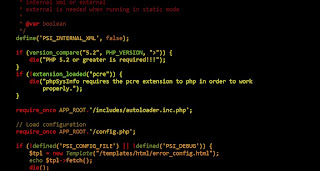Outline for Mastering PHP: A Comprehensive Guide to User-Friendly and SEO-Optimized Web Development
Introduction
- Overview of PHP: Brief history, evolution and significance of It in web development.
- Purpose of the Guide: End learning curves and how it will enable them in web development.
- Target Audience: Who is going to benefit from this guide from its basic to advanced users including SEO specialists.
CHAPTER 1: KNOWING PHP
- What is PHP?: Definition And Basic Concepts
- How PHP Works: As a server-side script and Interacts with Databases.
Mastering PHP: A Complete Guide to User-Friendly and SEO-Friendly Web Development
Introduction
- Overview of PHP In brief, its history, growth, and importance in web design are provided.
- Purpose of the guide: Going beyond learning curves and how it will benefit them in web design.
- The intended reader: Who is to benefit from the guide and how, from the beginner level to advanced practitioners including those who do SEO.
CHAPTER 2: PREPARING THE PHP DEVELOPMENT ENVIRONMENT
- Downloading and Installing PHP: Figure out the download and installation processes depending on the configuration of the device (Windows, macOS, Linux).
- How to Configure PHP: php.ini setup, error reporting, performance improvement.
CHAPTER 3: PHP Essentials Requirements of PHP
- Dimensions or Valuables expose the Filled-up – compositions of words, numbers, some catalogues and objects, etc.- Control Structures: Rescinds: if, switch, cycles.
- Functions and Scope: motion directed to filling up a form or putting down: filling collecting information during a period for occurrence of case purpose – case function scope.- Or focus on rejecting the case purpose - case function scope.
CHAPTER 4: PHP Advanced Features with tools
- Object Oriented Programming: Functions from classes, their interrelations and relatives strarts the search for many daughters, and implementing many daughters’ relational interface – polymorphism.- Namespaces and Autoloading – Organizing the code in accordance with PSR’s guidelines.
- Traits and Interfaces – A code reuse pattern that concerns itself with single purpose decks.
- Exceptions and user defined exceptions – Definition and use of custom exception types.
Chapter 5: Visualizing Database
- Introduction to DBMS: Short overview about MySQL, PostgreSQL and SQLite.
- Database Connectivity: PDO, MySQLi.
- Handling with Basic Operations: enjoying the PHP facilities for creating, fetching, updating, and deleting entities.
- Prepared Statements: Probed Isolation – reasons and benefits of such safety and speed rating features.
Chapter 6: PHP and Forms
- Form Data Submission and Processing: using GET and POST methods, form data editing.- Sanitizing and Validating Input: Dangers from SQL injection, XSS attacks.
- File Uploads: Implementation of secure file uploads in applications.
Chapter 7: PHP Security Best Practices
- Content Validation: The safeguard of information from compromise and risk.
- Controlling Access Sessions: Measures taken to prohibit unauthorized access to a user's active session.
- Protecting Credentials: Implementing bcrypt, Argon2.
- Defending Against Common Threats: SQL injectable, Cross Scripting, Cross-site request forgery.
Chapter 8: Writing Code in PHP The Easier Way
- Handling Errors and Debugging: Strategies and available instruments.
- Writing Code Documentation: Usefulness of comments and technical workings.
- Ensuring Code Integrity: Employing linters and formatters and compliance with code standards.
- Source Code Management: Basic understanding of GIT principles and humanitarian approaches to work.
Chapter 9: SEO Optimization with PHP
- Basics of SEO: Knowledge of search engine working and ranking parameters.- Modification for SEO-URLs Creation: mod_rewrite, clean URLs.
- Meta Tags and Headers: Meta tags creation at run-time using PHP.
- The sitemaps and The Robots Txt: Creating sitemaps and controlling how search engines index the pages.
- Performance tuning: Usage of various caching methods and avoidance of high loading times.
Chapter 10: PHP and Front-End Technologies – Stand Out Game
- The use of PHP in HTML: Mixing Php Code with Html.- PHP and JavaScript: Making AJAX calls and getting JSON back.
- PHP and CSS: Creating styles on the fly.
- Responsive Web Design: Using PHP with responsive design frameworks.
- Content Management Systems (CMS): Create the simplest content management system possible.
- E Commerce Applications: Development of a basic online shopping cart.
- Application program interfaces (APIs) and Web Services: Application programming interface and web service development via REST architecture.
- User Authentication Systems: Implementation of a sign up and sign in mechanism.
Chapter 12: Most Efficient Uses of PHP and its Trends
- Scripting Conventions: codemodels standards, scripting etiquette.- PHP Frameworks: a brief overview of Laravel, Symfony, CodeIgniter.
- The Future Of PHP: New features and changes which can be expected concerning PHP.
- Community and Resources: Usenet groups, articles, courses, and manuals on the net.
Conclusion
- A Brief Refresher: Insight into the main highlights of the guide.
- What’s The Next Step?: Suggestion on what they would want to learn more and practice.
- It’s Encouraged To Put Things Into Practice: Stress on learning and doing.
Key Sections To Elaborate:
1. Introduction to PHP:- Cover Some Historical Background, Pick Most Important Aspects Of PHP In Web Development Today, And Discuss The Woman-and-mother Community.
2. PHP Setup:
- Give Installation Instructions For Multiple Environments, Including Troubleshooting Under Different Scenarios, And Examples For Configuration.
3. In the Core And In the Details of PHP:
- Exhaustive Explanations With Code Implementation And Recommended Practices In Use.
4. Connecting and Working With The Database:
- Showcase In Some Applications Ready For Use, Suggest How To Improve Them Performance-wise.
5. Dealing With Security:
- The Entire Spectrum Of Security Work Will Be Presented, Citing Examples Of Security Threats.
6. SEO:
- The Most Effective Techniques For Implementing SEO Elements In PHP Applications – In More Depth And With Cases.
7. Interaction With Front End Technologies:
- Integration issues, code samples and how to avoid the friction.
8. Implementation of Products:
- Sample Applications With Stepwise Explanation With Codes And Screenshots.
9. Ideal Concepts and Trends:
- Digging Detailing Trends, Future Features and Community thoughts.














0 Comments